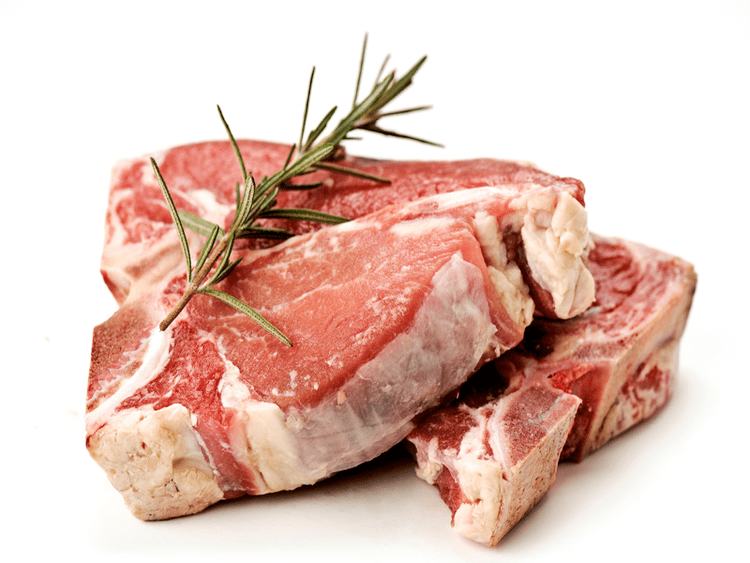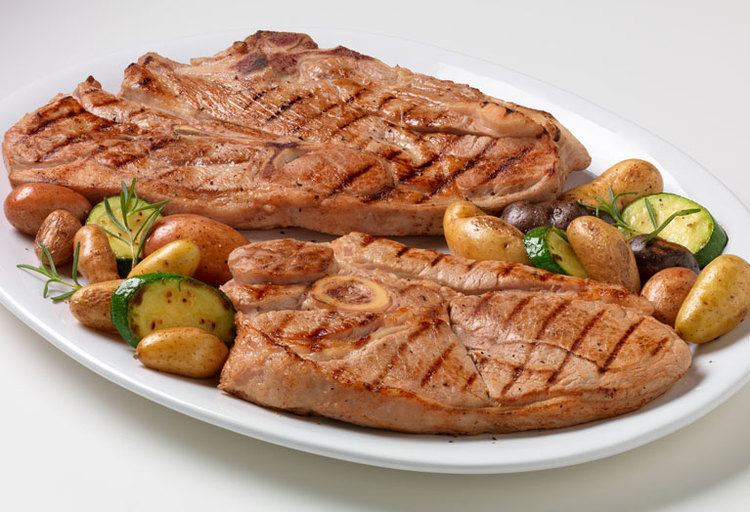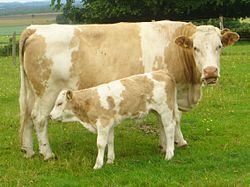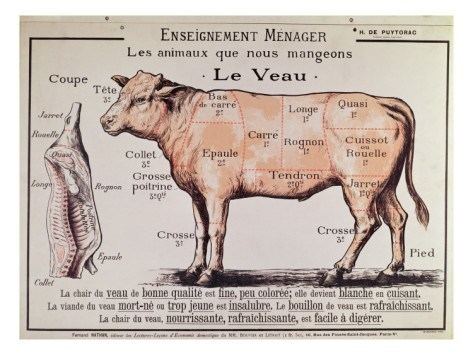 | ||
Similar Meat, Lamb and mutton, Beef, Pork, Chicken meat | ||
Veal production
Veal is the meat of calves, in contrast to the beef from older cattle. Veal can be produced from a calf of either sex and any breed; however, most veal comes from young males of dairy breeds who are not used for breeding. Generally, veal is more expensive than beef from older cattle.
Contents
- Veal production
- Types
- Culinary uses
- At birth
- Housing
- Feeding
- Health
- Animal welfare
- Restricted space
- Abnormal gut development
- Abnormal behaviours
- Increased disease susceptibility
- Veal crates
- Drug use
- Europe
- United States
- References

Some methods or aspects of veal production are controversial due to animal welfare concerns.
Types
There are several types of veal, although some terminology varies by country. Types of veal include:

Culinary uses

Veal has been an important ingredient in Italian and French cuisine from ancient times. The veal is often in the form of cutlets, such as the Italian cotoletta or the famous Austrian dish Wiener Schnitzel. Some classic French veal dishes include fried escalopes, fried veal Grenadines (small, thick fillet steaks), stuffed paupiettes, roast joints, and blanquettes. Because veal is lower in fat than many meats, care must be taken in preparation to ensure that it does not become tough. Veal is often coated in preparation for frying or eaten with a sauce. Veal Parmigiana is a common Italian-American dish made with breaded veal cutlets.
In addition to providing meat, the bones of calves are used to make a stock that forms the base for sauces and soups such as demi-glace. Calf stomachs are also used to produce rennet, which is used in the production of cheese. Calf offal is also widely regarded as the most prized animal offal. Most valued are the liver, sweetbreads, kidney, and bone marrow. The head, brains, tongue, feet, and mesentery are also valued.
At birth

Male dairy calves are commonly used for veal production as they do not lactate and are therefore surplus to the requirements of the dairy industry.

Newborn veal calves are generally given only a limited amount of time with their mothers, varying from a few hours to a few days. Free-raised calves are raised alongside their mothers, and always have access to their mothers' milk, but this is an extremely rare occurrence.
Housing
Three different primary types of housing used for veal calves: hutches, stalls, or various types of group housing.
Feeding
"Milk-fed" veal calves consume a diet consisting of milk replacer, formulated with mostly milk-based proteins and added vitamins and minerals. This type of diet is similar to infant formula and is also one of the most common diets used for calves in the veal industry.
"Grain-fed" calves normally consume a diet of milk replacer for the first six to eight weeks and then move on to a mostly corn-based diet.
"Free-raised" calves are raised on open pastures and receive a diet of milk, grass, and fresh water. Furthermore, free-raised calves do not receive antibiotics, which are often a focus of criticism among animal welfare organizations.
Health
Veal farmers have a priority to provide quality care to the calves that are raised on the farm. A farm veterinarian will create and provide a health program that will promote a healthy herd. Veal calves need proper amounts of water, adequate nutrition, and safe and comfortable environments to thrive.
Animal welfare
Some methods of veal production are controversial due to animal cruelty. Multiple animal welfare organizations consider several practices and procedures of veal production to be inhumane. Public efforts by these organizations are placing pressure on the veal industry to change some of its methods.
Some inhumane practices are relevant to both group and in individually housed systems.
Restricted space
One example of cruelty in the veal industry, is the lack of space veal calves are provided. Space is often deliberately restricted by the producer to stop the animal exercising as this makes the meat turn redder and tougher.
Abnormal gut development
Some systems of veal production rear calves that are denied access to any solid feed and are fed a liquid milk replacer. They may also be deprived of bedding to prevent them from eating this. This dietary restriction completely distorts the normal development of the rumen and predisposes the calf to infectious enteritis (scouring or diarrhoea) and chronic indigestion. Furthermore, calves with an underdeveloped gut are more likely to be found to have hairballs in the rumen at slaughter; the accumulation of hairballs in the rumen can impair digestion.
Abnormal behaviours
Rearing calves in deprived conditions without a teat can lead to the development of abnormal oral behaviour. Some of these may develop into oral stereotypies such as sucking, licking or biting inanimate objects, and by tongue rolling and tongue playing. "Purposeless oral activity" occupies 15% of the time in crated calves but only 2–3% in group-housed calves.
Increased disease susceptibility
Veal calves' dietary intake of iron is restricted to achieve a target haemoglobin concentration of around 4.6 mmol/l; normal concentration of haemoglobin in the blood is greater than 7 mmol/l. Calves with blood haemoglobin concentrations of below 4.5 mmol/l show clear signs of increased disease susceptibility and immunosuppression.
Alternative agricultural uses for male dairy calves include raising bob veal (slaughtered at two or three days old), raising calves as "red veal" without the severe dietary restrictions needed to create pale meat (requiring fewer antibiotic treatments and resulting in lower calf mortality), and as dairy beef.
In 2008 to 2009 in the US, the demand for free-raised veal rose rapidly.
Veal crates
Veal crates are a close-confinement system of raising veal calves. Many calves raised for veal, including in Canada and the US, are confined in crates which typically measure approximately 66–76 cm (2.1-2.5 ft) wide. The calves are housed individually and the crates usually prevent physical contact between adjacent calves, and often prevent visual contact. Crated calves are sometimes tied to the front of the crate with a short tether which restricts almost all movement. Floors are often slatted and sloped. This allows urine and manure to fall under the crate to help maintain a clean environment for the calf. In some veal crate systems, the calves are also kept in the dark without bedding and fed nothing but milk. Veal crates are designed to limit movement of the animal because meat turns redder and tougher if the animals are allowed to exercise. The diet is sometimes highly regulated to remove sources of iron, which again makes the meat redder.
In the US, the use of crates to prevent movement by veal calves is a principal source of controversy in veal farming. Many veal farmers started improving conditions in their veal farms in the 2000s. Veal crating is criticized because the ability of the calves to move is highly restricted; the crates have unsuitable flooring; the calves spend their entire lives indoors, experience prolonged sensory, social, and exploratory deprivation; and the calves are more susceptible to high amounts of stress and disease.
Cruelty to calves
Abnormal bone and muscle development: Calves need to exercise to ensure normal bone and muscle development. Calves at pasture not only walk but also run about, jump and play. Calves in veal crates cannot turn around let alone walk or run. When finally taken out of their crates to go for slaughter, calves may stumble or have difficulty walking. There is a general increase in knee and hock swelling as crate width decreases.
Social deprivation: Under natural conditions calves continue to suckle 3 to 6 times a day for up to 5 months. Clearly, veal crates prevent this social interaction. Furthermore, many calves are reared in crates with solid walls that prevent visual or tactile contact with their neighbours. It has been shown that calves will work for social contact with other calves.
To maintain personal hygiene and help prevent disease, calves lick themselves to groom. Cattle naturally lick all the parts of their body they can reach, however, tethering prevents calves from licking the hind parts of their body. Excessive licking of the forelegs (another abnormal behaviour) is common in stall and tether systems.
Drug use
United States Department of Agriculture (USDA) regulations do not permit the use of hormones on veal calves for any reason. They do, however, approve the use of antibiotics in veal raising to treat or prevent disease.
In 2004, the USDA expressed concern that the use of illegal drugs might be widespread in the veal industry. In 2004, a USDA official found a lump on a veal calf in a Wisconsin veal farm, which turned out to be an illegal hormone implant. In 2004, the USDA stated "Penicillin is not used in calf raising: tetracycline has been approved, but is not widely used."
Europe
In 1990, the British government banned transporting calves in close-confinement crates. Veal crates were banned across the EU in January 2007.
Veal calf production, as such, is not allowed in many northern European countries, such as in Finland. In Finland, giving feed, drink or other nutrition which is known to be dangerous to an animal which is being cared for is prohibited, as well as failing to give nutrients the lack of which is known to cause the animal to fall ill. The Finnish Animal Welfare Act of 1996 and the Finnish Animal Welfare Decree of 1996 provided general guidelines for the housing and care of animals, and effectively banned veal crates in Finland. Veal crates are not specifically banned in Switzerland, but most calves are raised outdoors.
United States
In 2007, the American Veal Association passed a resolution encouraging the entire industry to phase out crate confinement of calves by 2017.
As of 2015, eight US states ban veal crates. Nationally, several large veal producers and the American Veal Association are also working to phase out the industry use of veal crates. State-by-state veal crate bans are as follows:
Current active legislation in:
